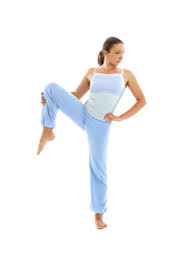How to Do Standing Open Knee Pose in Yoga

Standing Open Knee Pose is yoga pose that strengthens the core muscles while improving balance. It is a variation of the intermediate yoga posture, Standing Hand to Big Toe Pose B (Utthita Hasta Padangusthasana B) that is more appropriate for newer students and for those who are still building strength.
Standing Open Knee is also a good preparatory pose for more challenging balance poses, like Tree Pose (Vrksasana), and for deep hip-openers, like One-Legged King Pigeon Pose (Eka Pada Rajakapotasana). This pose is usually practiced directly after Standing Knee Hug without lowering the leg.
Benefits of Standing Open Knee Pose
Standing Open Knee Pose strengthens and tones the thighs, calves, and ankles. It also stretches the hamstrings and the hips. Balancing on one leg tones and strengthens your core muscles — your abdominal muscles and lower back — making this pose therapeutic for lower back pain. Focusing your mind in order to balance reduces stress and calms your thoughts. By learning to hold the pose even when you're feeling wobbly, you also learn to confront challenges in your everyday life with grace and ease.
Balance is not something you achieve and hold on to. It's more ephemeral; it's a string of temporary successes, held momentarily, lost, and then discovered again.
Cautions
Do not practice this pose if you have a recent or chronic ankle or low back injury. Always work within your own range of limits and abilities. If you have any medical concerns, talk with your doctor before practicing yoga.
Instructions
- Begin standing in Mountain Pose (Tadasana) with your feet together and arms at your sides.
- Let your breath be soft. Allow your thoughts to settle on the present moment. Gently gaze at a fixed spot in front of you.
- Shift your weight to your left foot. Bring your left hand to your hip. Slowly draw your right knee up toward your chest. Using your right hand, hug your knee into your chest.
- Hold here for a few breaths. If you feel comfortable and steady, and if you can maintain a straight spine, use your right hand to help open your right knee to the side. Let your right leg's shin and foot dangle just beneath your right knee.
- Engage the muscles of your left leg, but do not lock your knee. Draw your abdominal muscles in to help stabilize your body from the core.
- Drop your right hip slightly, so it's in line with your left hip. Keep your spine straight and your shoulders relaxed.
- Turn your head to the left and gaze out at the horizon, beyond your left shoulder.
- Hold for 5-20 breaths. To release the pose, bring your knee back to center and hug it into your chest. Then slowly lower your foot to the floor. Come back to Mountain Pose. Repeat on the opposite side for the same amount of time.
Modifications & Variations
Standing Open Knee can open up your hips and lower back, which can feel great after a long day of sitting or traveling. Try these simple changes to find a variation of the pose that works for you:
- If you are unable to hold your raised knee, try using a yoga strap. Wrap the strap around the knee of your raised leg and hold both ends of the strap in the same-side hand. Keep your opposite hand on your hip for balance.
- To support the lifted leg as you gain strength and flexibility, rest your raised foot along the top edge of a stair, stack of heavy books, or another secure, flat surface.
- For extra help with balance, extend the hand that is on your hip out to the side, parallel to the floor with your palm facing forward.
- For even more help with balance, try practicing the pose with your back against a wall. Alternatively, you can place a chair next to the standing-leg side of your body and rest your hand on the back of the chair (instead of your hip) for extra support.
Tips
Standing Open Knee Pose can help you gain strength and flexibility, which will improve all of your standing yoga poses! Keep the following information in mind when practicing this pose:
- Don't rush! Come into the pose slowly and with awareness. It's easier to gain and maintain your balance if you move slowly, rather than coming into it too fast.
- Bring your attention to your midline — the vertical line that runs directly through the center of your head, neck, and torso.
- Regularly practicing Standing Open Knee will tone your abdominal muscles, but weaker core muscles can make it difficult to balance when you're new to the pose. Add core-strengthening poses into your practice to help with balancing. Try Boat Pose (Navasana) and Plank Pose (Kumbhakasana).
Lift & Open
Adding Standing Open Knee to your regular practice will improve your ability to focus with a clear and calm mind. It will also help prepare your mind and body for more challenging poses! Balance comes with practice, so be sure to take it slowly. It's okay to fall! Just try the pose again. With patience and dedication, you'll be able to hold this pose with poise, grace, and serenity.

